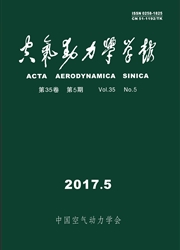

 中文摘要:
中文摘要:
对两种收扩喷管推力矢量控制技术:激波矢量控制技术和喉部偏移控制技术,进行了流场计算和性能比较。本研究中,喷管进口至喉部几何型面固定,扩张段长度为定值,二次流喷射位置、角度保持不变,采用CFD数值模拟方法计算喷管膨胀比不同时的流场。从计算结果可以看出,喉部偏移控制技术适用于膨胀比小于1,5的收扩喷管,而激波矢量控制技术适用于膨胀比大于1.5的收扩喷管。喉部偏移控制技术的特点在于其可以限制喷管主流流量,影响主、次流流量比的主要因素为二次流与主流的总压比。
 英文摘要:
英文摘要:
Thrust vectoring can provide fighter with advantages regarding performance, survivability and detectability. Two types of fluidic control Convergent-Divergent nozzle thrust vector technology, which are Shock Vectoring controlling and Throat Shift, are numerically simulated and their performances are analyzed. A nozzle with fixed geometry from nozzle inlet to throat, and fixed length of divergent flap is researched. The relative position of the secondary injecting flow is fixed, and the injecting direction is always vertical to the nozzle main flow. The nozzle flow fields are obtained via CFD numerical simulation. It can be seen from the results that, Throat Shift method is suitable for the nozzle expansion ratio less than 1.5, and Shock Vectoring controlling method is contrary to Throat Shift method, which is suitable for the nozzle expansion ratio greater than 1.5. The Throat Shift method can restrict the nozzle mass flow besides thrust vectoring. The main influence of the secondary mass flow is the ratio of secondary total pressure to main flow total pressure.
 同期刊论文项目
同期刊论文项目
 同项目期刊论文
同项目期刊论文
 期刊信息
期刊信息
